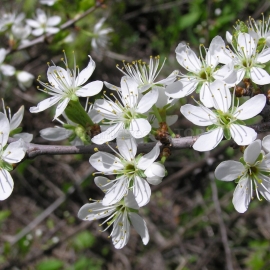








Organic Blackthorn Seeds (Prunus spinosa)
2.00 €
A small thorny shrub from the genus Plum, 3.5-4.5 m high, less often a low-growing tree no higher than 8 m, growing, forms dense thorny and impassable thickets, edible fruits similar to a plum, up to 12 mm in diameter.
-
Organic Blackthorn Seeds (Prunus spinosa)
Small thorny bush; species of the genus Plum (Prunus) of the subfamily Prunoideae of the Rosaceae family, stone fruit culture.
The word "turn" goes back to praslav. * tьrnъ ("thorn").
A shrub with a height of 3.5-4.5 m, less often a low-growing tree no higher than 8 m. Growing, blackthorn forms dense thorny and impassable thickets. The branches are abundantly covered with thorns.
Leaves are elliptical or obovate, toothed, up to 5 cm long.
The flowers are small, white, open singly or in pairs in early spring, when there are no leaves yet.
Fruits are rounded monochromatic plants, similar to a plum, with a gray waxy coating, 12 mm in diameter.
A honey plant, gives bees mainly pollen-pollen and a little nectar. Blackthorn wood is very strong and hard, with a beautiful brownish-reddish color. Such wood lends itself well to polishing. Blackthorn wood is used in the production of small joinery and turning products, walking sticks. Blackthorn is also used as decorative hedges. Thorn bushes are specially planted on slopes, in ravines, along the banks of rivers and canals to strengthen them. Serves as an excellent stock for shrub forms of peach, apricot and plums.
A crown of thorns is a crown made of the branches of a plant with thorns (thorns), which, according to the Gospels, was placed on the head of Jesus Christ by the Roman soldiers during His mockery. About when the crown of thorns was removed is not written in the canonical Gospels. Some artists paint Jesus Christ on a cross with a crown of thorns. Today, the relic, revered as the Crown of Thorns of the Lord, is in Paris, in the Cathedral of Notre Dame de Paris.
On the territory of the former USSR, in the wild, it is distributed in the southern and central regions of the European part, in Siberia, in the Caucasus; grows in clumps on forest edges and clearings, along ravines and river valleys. The most common varieties of large-fruited blackthorn, bred by crossing with home plum.
Blackthorn is a perennial highly branched shrub 1-3 m high. Branches with thorns. Forms root shoots abundantly. Young shoots are pubescent, occasionally glabrous. The kidneys are spherical, located in internodes by 2-3. Leaves petiolate, obovate, crenate-serrate along the edge, pubescent, almost glabrous with age. Early flowering (April - May), before the leaves open.
Flowers are solitary (in each flower bud - 1 flower), pinkish-white, pollinated mainly by bees. Fruits (drupes) are small (up to 2-3 cm in diameter), round, black or dark blue, with a strong waxy coating, with a green sweet and sour pulp with a tart taste, sit on a thick stalk. After freezing, the fruits are sweeter.
Productivity 3-4 kg of fruits from an adult bush.
Blackthorn wood is very strong. The bark is brown or dark red. The roots are numerous and powerful. The plant is frost and drought resistant, photophilous. Thorns bear fruit from 2-3 years of age. Fruits are round, small (10-15 mm in diameter), black-blue in color with a waxy coating. The pulp is green. The seeds are not separated from the pulp. The fruits ripen in August-September and stay on the tree all winter until spring. The fruits are tart-sour to taste, ripen late, but the plant bears fruit annually and abundantly. After the first frost, the astringency decreases.
Popular names: oat plum, sour plum, black thorn, prickly plum, teren.
